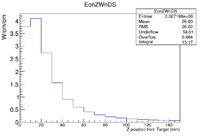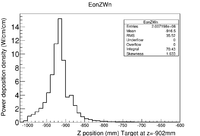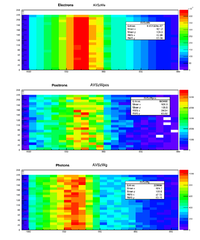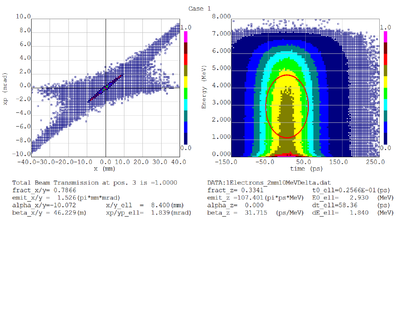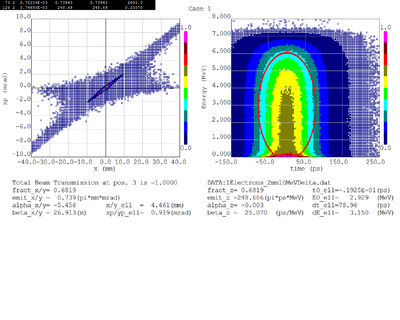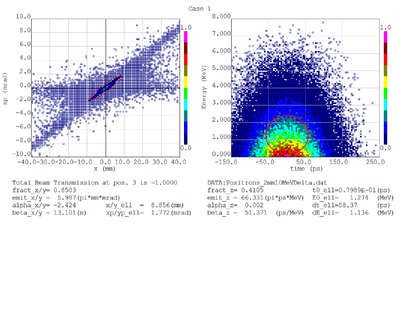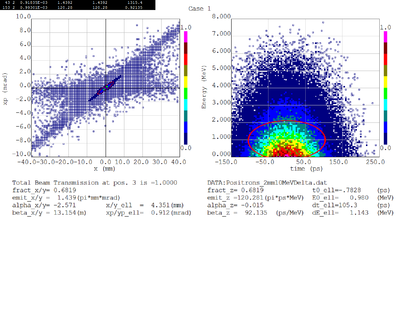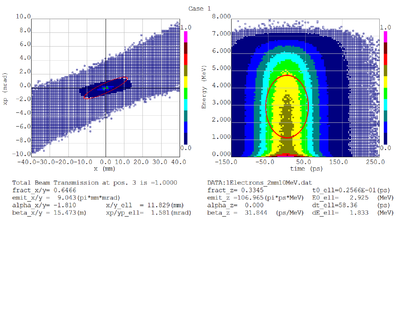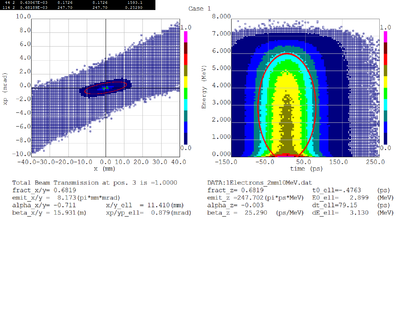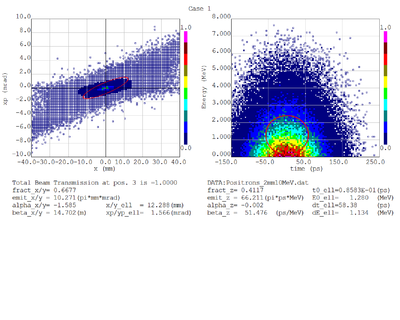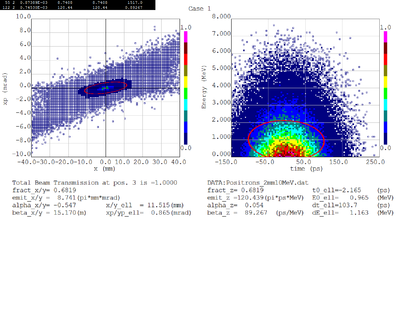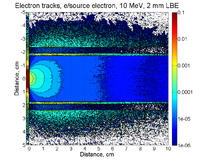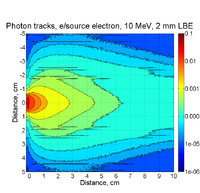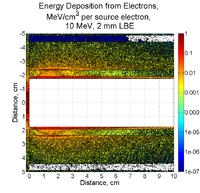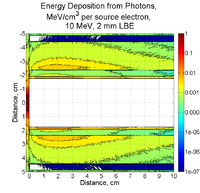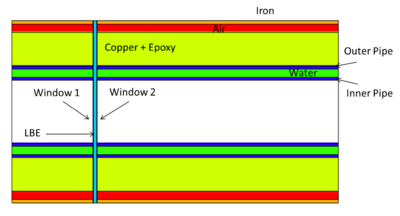G4Beamline PbBi
Development of a Positron source using a PbBi converter and a Solenoid
Task List
1.) new electron and positron files for the case of two 0.25 mm thick SS windows around the PbBi target.
2.) Determine electron energy deposition in SS pipe per cm^2 of pipe surface area for pipes with a radius of 34.8, 47.5, 60.2, 72.9, and 97.4 mm and thickness of 5mm along the z-axis.
3.) Insert uniform B-field that can be scaled from 0 to 0.3 and 1 Telsa.
Beam Pipe Heating
A 10 MeV electron beam with a radius of 0.5 cm was incident on a 2 mm thick PbBi target. The target is positioned at Z = -902 mm. The plot below shows the energy deposited in MeV along the pipe. The Z axis is along the beam direction. The distance around the beam pipe is determine by taking the pipe radius (34.8 mm) and multiplying it by the Phi angle around the pipe. The bins are 1cm x 1cm.
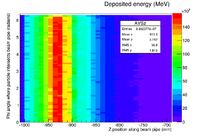 |
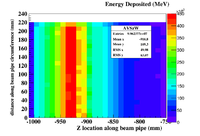
|
Beam Power = E(MeV) I ( A) = 10 MeV 1000 mA = 10 kW
If all of the beam power goes into a 150 cm long beam pipe with a radius of 3.38 cm then the power deposited per area would be
Projections onto the Z-axis
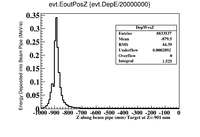
|
According to the above figure, GEANT4 predicts a total of MeV of energy will be deposited in a 1m long beam pipe surrounding a 2 mm thick PbBi target located at Z=-902 mm when 20 million electrons impinge the target.
If all of this energy were UNIFORMLY distriuted along the 3.48 cm radius pipe then the energy deposited per area would be
\sim \frac{0.23 \mbox{keV} }{ \mbox{cm}^2 \mbox{e}^- }
I converted the above histogram to deposited power you would divide by the number of incident electrons, divide by the circumference of the beam pip, multiple the beam current, and use a unit conversion from MeV to W-s per MeV.
Below is energy deposited contributions from from photons(AVSzWg), positrons (AVSzWpos), and electrons.
Why is the positron hotspot upstream of the target?
root commands used
TH2D *AVSz=new TH2D("AVSz","AVSz",100,-1000,0,12,-60,60)
BeamPipeE->Draw("35.*atan(PosYmm/PosXmm):PosZmm>>AVSz","DepEmeV");
AVSz->Draw("colz");
BeamPipeHeating_4mmthick_PbBi_PositronTarget
Unit conversion
The energy deposited by photon, electrons, and positrons is predicted by GEANT4 and recorded in energy units of keV per incident electron on the PbBi target. To convert this deposited energy to a power you need to assume a beam current. Assuming 1 beam current of 1 mA, the conversion is given easily as
Results Table
| Beam Pipe Radius (mm) | Hot Spot () |
| 34.8 | 5 |
| 47.5 | |
| 60.2 | |
| 72.9 | |
| 97.4 |
Converter target properties
Definition of Lead Bismuth
1cm diameter target
2 mm thick PbBi
0.5 Tesla solenoid
Desire to know
Emmittance (mrad * mm)
dispersion (Delta P/P) (mradian/1000th mm/1000th)
of electrons after the PbBi target.
pole face rotation in vertical plane.
G4BeamLine and MCNPX
Target thickness optimization
PbBi_THickness_GaussBeam
Dmitry's processing of Tony's GEANT simulations showing transverse phase space portrait (left) and longitudinal phase space portrait (right). Phase space portraits show coordinate x or y vs diveregense=px/pz or py/pz (or time vs kinetic energy ). Captions show:
1. geometric (not normalized) emittance for transverse and emittance for longitudinal phase space portraits (ellipse areas divided by "pi")
2. Twiss parameters
3. Ellipse centroid for longitudinal phase portrait
4. sqrt(beta*emittance) and sqrt(gamma*emittance) - half sizes of the projections of the ellipses on the coordinate and divergence axes respectively.
Electrons - RMS
Electrons - 68.2% core
Positrons - RMS
Positrons - 68.2% core
PbBi_THickness_CylinderBeam
Dmitry's processing of Tony's GEANT simulations showing transverse phase space portrait (left) and longitudinal phase space portrait (right). Phase space portraits show coordinate x or y vs diveregense=px/pz or py/pz (or time vs kinetic energy ). Captions show:
1. geometric (not normalized) emittance for transverse and emittance for longitudinal phase space portraits (ellipse areas divided by "pi")
2. Twiss parameters
3. Ellipse centroid for longitudinal phase portrait
4. sqrt(beta*emittance) and sqrt(gamma*emittance) - half sizes of the projections of the ellipses on the coordinate and divergence axes respectively.
Electrons - RMS
Electrons - 68.2% core
Positrons - RMS
Positrons - 68.2% core
PbBi_THickness_PntSource
Electrons and Positrons after 2mm of LBE:
Electrons:
Positrons:
Energy Deposition in Target system (Heat)
MCNPX simulations of energy deposition into different cells are below. There is a slight overestimate (they add up to about 120%). Positrons contribute less than 1% of electrons' contribution. No magnetic filed is assumed.
Solenoid
Inner Radiusu=
Outer Radius =
Length =
Current=
Magnetic Field Map in cylindrical coordinates (Z & R) from Niowave
